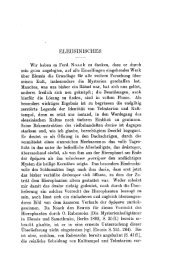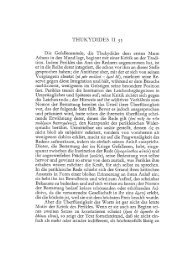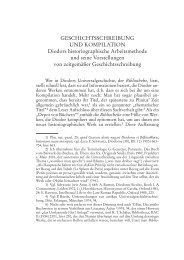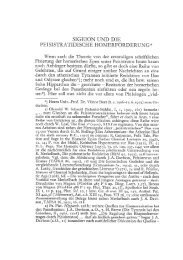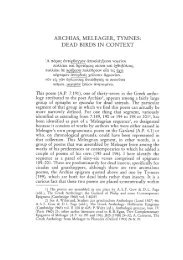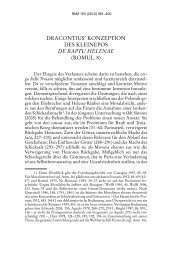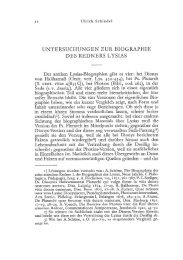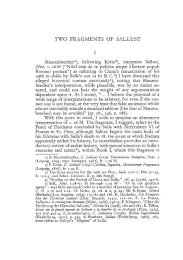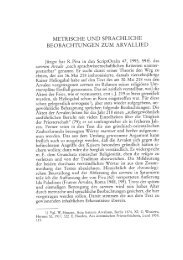APOTELESMATICA 2. (1) 14–140: SOURCES AND MODELS*
APOTELESMATICA 2. (1) 14–140: SOURCES AND MODELS*
APOTELESMATICA 2. (1) 14–140: SOURCES AND MODELS*
You also want an ePaper? Increase the reach of your titles
YUMPU automatically turns print PDFs into web optimized ePapers that Google loves.
78 Maria Ypsilanti<br />
includes ı aÈxØn toË §xom°nou ÖOfevw in the stars of the tropic,<br />
approved by Hipparchus (1.10,15) and followed also by Germanicus<br />
(467). 18 Pseudo-Manetho speaks of briaroË tÉ ÉOfioÊxou /<br />
vÖmouw, here agreeing with Aratus who deviates from Eudoxus who<br />
refers to ≤ kefalØ toË ÉOfioÊxou (fr. 66,13), both criticised by<br />
Hipparchus who rejects the head as well as the shoulders (1.10,9<br />
and 1.10,14). 19 Pseudo-Manetho, like Aratus and Eudoxus (fr.<br />
66,13 f.), includes the Bird’s neck in the circle 20 and omits Aratus’<br />
head of the Bird, staying close to Eudoxus who does not include<br />
the head, without including Eudoxus’ ka‹ ≤ éristerå pt°ruj<br />
which he however perhaps echoes with his tanusipterÊgoio; Hipparchus<br />
(1.10,8) totally rejects the occurrence of any part of the<br />
Bird in the tropic. Pseudo-Manetho refers to pÒdaw ÑIppe¤ouw, staying<br />
closer to Eudoxus fr. 66,14 ofl toË ÜIppou pÒdew, while Aratus<br />
describes them as ıpla¤, a statement criticised by Hipparchus<br />
(1.10,7): t¤naw m¢n oÔn ést°raw §t¤yei (Aratus) §p‹ ta›w ıpla›w toË<br />
ÜIppou, êdhlon. Pseudo-Manetho mentions only Andromeda’s<br />
égk≈n, while Eudoxus (66,14 f.) speaks of the dejiå xe‹r t∞w ÉAndrom°daw,<br />
and Aratus makes the distinction between Andromeda’s<br />
palm and elbow; the author of the Apotelesmatica deviates from<br />
Aratus who holds that the elbow inclines to the south, agreeing<br />
with Hipparchus’ comment that the elbow must be well to the<br />
north of the tropic (1.10,6); 21 he does not share Hipparchus’ view,<br />
however, that the elbow does not actually belong to the tropic and<br />
so refers to it by xeirÒw tÉ égk«na bore¤ou / ÉAndrom°dhw. Referring<br />
to the “wrist and the left leg” of Perseus, Pseudo-Manetho disagrees<br />
with both Aratus and Eudoxus who include the left shoulder<br />
of the hero in the tropic (Eud. fr. 66,15 f. toË Pers°vw ı éristerÚw<br />
Œmow ka‹ ≤ éristerå knÆmh), being closer to Hipparchus<br />
(1.10,5) who held that not only the left shoulder but also the central<br />
star of Perseus is farther north, while the left leg (1.6,13) is<br />
18) Primis ignibus Anguis. Germanicus, following Eudoxus, also speaks of a<br />
part of the Engonasin as included in the tropic, omitted by Aratus and Pseudo-<br />
Manetho, and accepted as correct by Hipparchus (1.10,15).<br />
19) For Aratus’ deviation from Eudoxus, probably due to the fact that<br />
Ophiouchus’ shoulders are brighter, see Kidd on Arat. 488.<br />
20) Omitted by Germanicus (465 f.), Hyginus (4.2,1) and Avienus (959 f.), see<br />
J. Soubiran, Aviénus, Les Phénomènes d’Aratos (Paris 1981) 231 f.<br />
21) For the lengths of Andromeda’s stars and Aratus’ deviation from his<br />
model see Kidd on Arat. 484.



